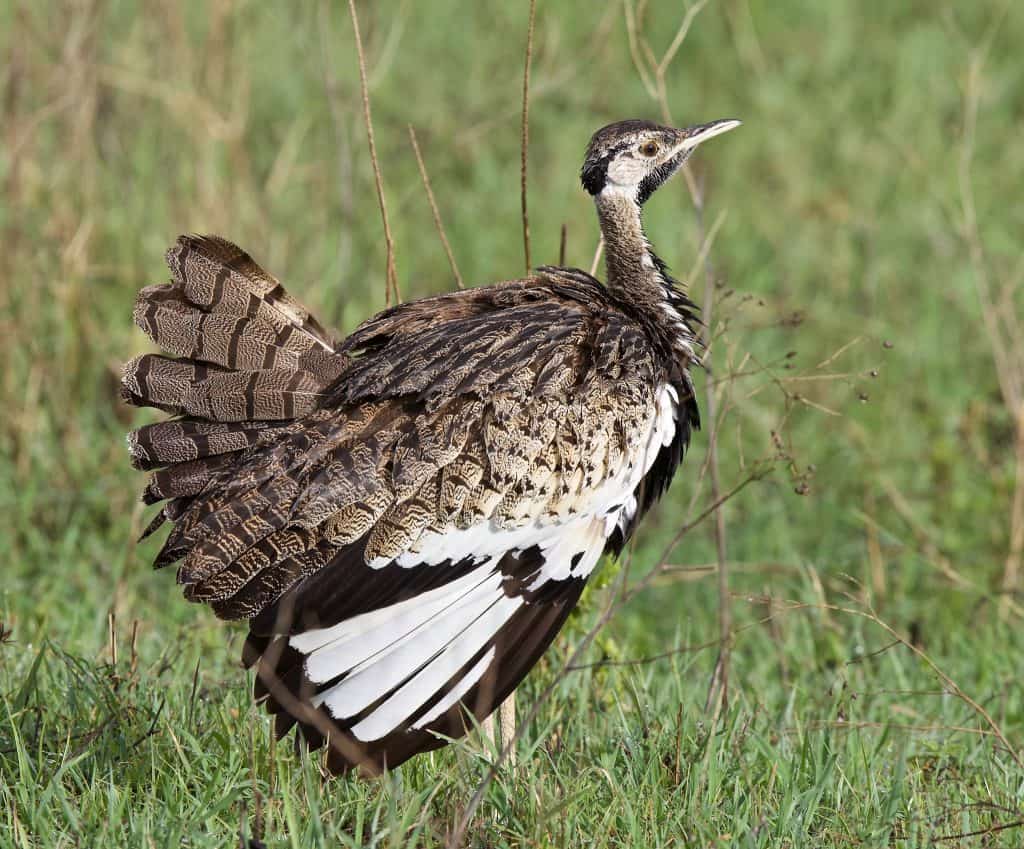Hearing a Black-bellied Bustard is an unusual experience. They have a rather striking call.
Identification assistance
The male and female Bustard differ in their plumage and colours.
The adult male has:
- Long legs and long slender neck.
- Large whitish cheek patch extends down sides of neck to form large white patches on either side of the breast.
- Head buffy-brown, with black eye stripe (mostly behind eye) and faint whitish supercilium.
- Hind neck buffy-brown, finely mottled darker brown.
- Back, rump, upper tail coverts and tail buffy brown, with prominent blackish chevrons; tail with 3-4 evenly spaced, darker brown bars.
- Upper wing coverts mostly buffy brown, with prominent blackish chevrons; white greater coverts form line along leading edge of folded wing.
- Underwing black, except for white flash in primaries. Black line down foreneck broadens onto a black breast and belly.
- Bill blackish.
- Eyes pale brown.
- Legs dull yellow.
The adult female has:
- Similar to adult male, but with plain brown head and neck.
- Chin and throat white.
- Breast buff, finely vermiculated with black; belly white.
- Greater coverts buff, with dark central spots.
- Primaries blackish, with white bars at base.
The juvenile has:
- As with the female, but cheeks, throat and neck rufous-brown.
- Buff tips to flight feathers and upper wing coverts.
Call
The male Bustard calls by slowly raising his neck, bill upwards and half open. The neck expands, displaying his black and white throat; with a slight tuft at the nape and pale ear covert feathers raised. This gives a drawling, frog-like quark; as he immediately pulls his head back onto his shoulders with his bill horizontal, then extends his neck and gives abrupt, explosive kww-ick, like a cork being pulled from a bottle.
This is repeated every 10-15 sec, for 30 minutes or more. They sometimes calls at night. Males gives a growling call when fighting and an alarm call that sounds like a hoarse krak. Half grown young give a high-pitched wailing call when handled.
Diet
The Bustard forages by walking and pecking close to the ground. They are omnivorous and feed on mainly small invertebrates (especially locusts, grasshoppers and beetles), as well as caterpillars, termites, mantids, crickets, Hemiptera, cicadas, ant-lions, wasps, ants, cockroaches and centipedes; also including vegetable matter (berries, seeds, fruits, flowers, palm kernels and green leaves).
Habitat
This Bustard inhabits the tall dense grassland and grassy savannah, in both hilly and flat country, where the rainfall is more than 600 mm.

Lifecycle
The bustard is likely polygynous and a solitary nester. Its eggs are laid directly on the ground, in a shallow scrape, among tufts of tall (under 1 m) grass; sometimes at the base of sapling or termite mound.
The eggs are virtually spherical; some with nodules at ends. They are olive green to olive-brown, with yellowish- and chocolate-brown markings, underlain with purple or grey in colour. The eggs are incubated for a period of 23 days (in captivity); by the female only.
Males will display at regularly used sites and the females nest away from display arenas. Males may gather in loose leks with 4 displaying males and 1 young male in close proximity at 1 site. The male display flight will typically occur after rain, in late afternoon and after calling.
They fly high up, with exaggerated wing-beats, displaying white primaries (wings raised high on upstroke, almost touching over back; barely reach horizontal on downstroke), with breast feathers puffed out. They return to ground in a shallow glide with wings held in deep ‘V’. Aerial displays and calling are concentrated in pre-breeding season.
In courtship, the male approaches the female Bustard, with mincing steps and the neck outstretched, throat puffed out, along with head and neck feathers raised to form ruff. He repeatedly retracts and stretches out his neck horizontally, and then raises it back to vertical position with sinuous, reptilian movement.
The male also runs after the female in crouched position, with tail raised vertically while competing males strut in front of each other; they fight with heads down, feathers fluffed out, rearing up to kick, tails raised, giving growling calls.
If you want to witness one of these unusual sounding Black-bellied Bustard’s, contact us and find out how you can book a tour at www.tanzaniabirding.com.
Source: Roberts Birds

